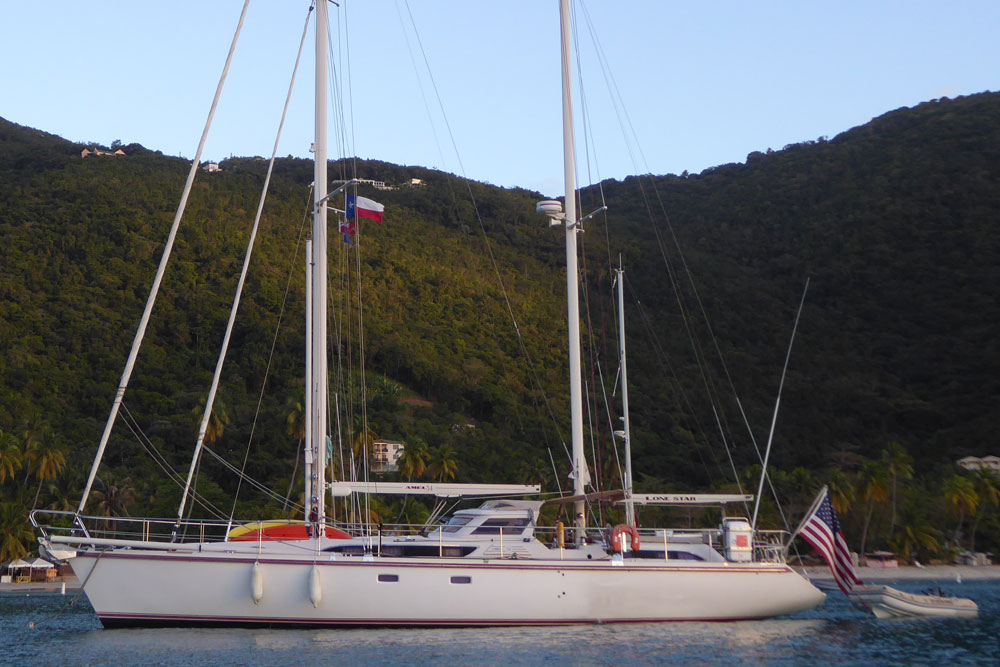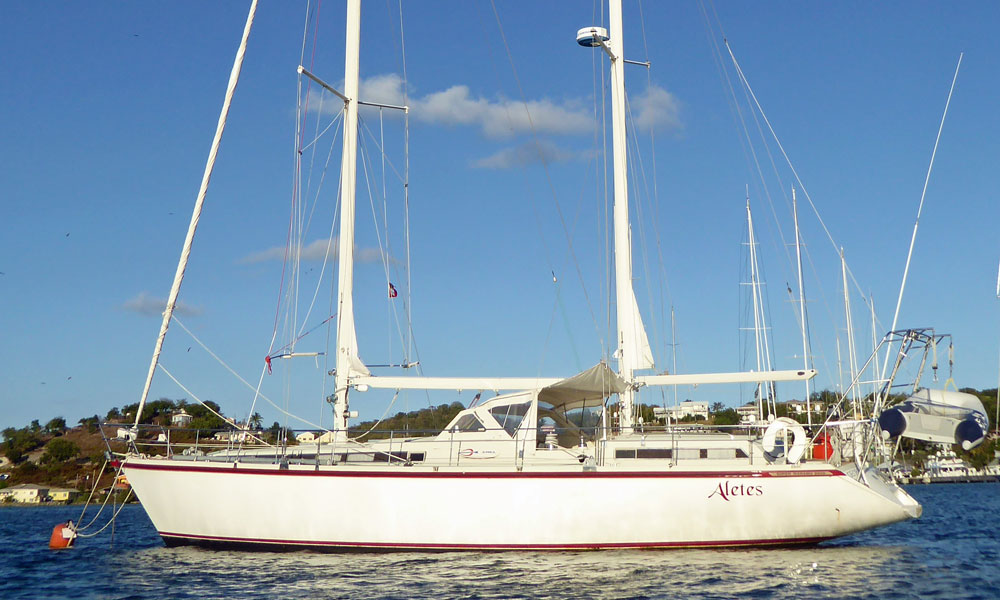- Home
- Sailboats 50'-55'
- Amel Super Maramu 2000
The Amel Super Maramu 2000 Sailboat
Specs & Key Performance Indicators
The Amel Super Maramu 2000, a centre-cockpit ketch, was designed by Henry Amel & J. Carteau and built in France by Amel.
Published Specification for the Amel Super Maramu 2000
Underwater Profile: Wing keel & skeg-hung rudder
Hull Material: GRP (Fibreglass)
Length Overall: 52'6" (16.0m)
Waterline Length: 41'4" (12.6m)
Beam: 15'1" (4.6m)
Draft: 6'8" (2.0m)
Rig Type: Ketch
Displacement: 35,274lb (16,000kg)
Designer: Henri Amel
Builder: Amel (France)
Year First Built: 1999
Year Last Built: 2007
Number Built: 245
Published Design Ratios for the Amel Super Maramu 2000
1. Sail Area/Displacement Ratio: 19.0
2. Ballast/Displacement Ratio: 34.4
3. Displacement/Length Ratio: 226
4. Comfort Ratio: 32.9
5. Capsize Screening Formula: 1.8
Performance Predictions, Based on the Design Ratios
One way to evaluate the performance potential of a sailboat is to look at some of its design ratios, such as the sail area/displacement ratio (SA/D), the displacement/length ratio (DLR), the ballast/displacement ratio (B/D) and the capsize screening formula (CSF). These ratios can give us some clues about how fast, stable, comfortable and safe a sailboat is, but they are not definitive indicators. They should be used with caution and in conjunction with other factors, such as the hull shape, the rig configuration, the sail plan, the construction quality and the equipment level.
The SA/D ratio measures how much sail area a boat has relative to its displacement. It indicates how well a boat can accelerate and maintain speed in different wind conditions. A higher SA/D ratio means a more powerful sail plan, while a lower SA/D ratio means a more conservative one. The Super Maramu 2000 has an upwind SA/D ratio of 19.0 and a downwind SA/D ratio of 19.2. These are moderate values that suggest a balanced sail plan that can perform well in light to moderate winds, but may need some reefing in stronger winds.
The DLR measures how heavy a boat is relative to its waterline length. It indicates how easily a boat can move through the water and how much resistance it encounters. A lower DLR means a lighter and faster boat, while a higher DLR means a heavier and slower boat. The Super Maramu 2000 has a DLR of 226. This is also a moderate value that suggests a medium displacement cruiser that can carry a lot of cruising gear without compromising too much on speed.
The B/D ratio measures how much ballast a boat has relative to its displacement. It indicates how stable and stiff a boat is when heeled over by the wind. A higher B/D ratio means a more stable and powerful boat, while a lower B/D ratio means a less stable and more tender boat. The Super Maramu 2000 has a B/D ratio of 34.4. This is a fairly high value that suggests a very stable boat that can handle rough seas and strong winds with confidence.
The CSF measures how prone a boat is to capsize when hit by a large wave. It indicates how safe a boat is in extreme conditions. A lower CSF means a more seaworthy boat, while a higher CSF means a less seaworthy boat. The Super Maramu 2000 has a CSF of 1.8. This is a low value that suggests a very safe boat that can withstand severe weather and survive knockdowns.
Based on these design ratios, we can predict that the Amel Super Maramu 2000 is a well-rounded cruising sailboat that offers good performance, stability, comfort and safety in various sailing conditions.
Production Period and Numbers Produced
The Super Maramu 2000 was produced from 1999 to 2007 by Amel in La Rochelle, France. It was an updated version of the original Super Maramu, which was launched in 1989 and became one of the most popular models of the Amel range. The main differences between the two versions were:
- The Super Maramu 2000 had more sail area than the original Super Maramu (119 m² vs 108 m²).
- The Super Maramu 2000 had an optional Yanmar engine upgrade from 78 HP to 100 HP.
- The Super Maramu 2000 had some improvements in the interior layout and equipment level.
- A total of 247 hulls were completed during the production period. The hull numbers ranged from #261 to #507. The Super Maramu 2000 was replaced by the Amel 54 in 2007.
Alternative Versions & Options
The Super Maramu 2000 was offered in a standard version and a red line version. The red line version had some extra features, such as:
- A red hull stripe and a red spinnaker.
- A watermaker, a generator, a washing machine and a dishwasher.
- A bow thruster, an electric furling genoa and an electric winch for the mainsail.
The Super Maramu 2000 also had some optional extras, such as:
- A Yanmar engine upgrade from 78 HP to 100 HP.
- A hardtop for the cockpit.
- A retractable gangway for the stern.
- A solar panel array on the aft deck.
Number & Location of Sleeping Berths
The Super Maramu 2000 has three cabins and two heads, providing six sleeping berths in total. The layout is as follows:
- The forward cabin has a double berth, a hanging locker, a vanity table and an en-suite head with shower.
- The aft cabin has a double berth, a hanging locker, a desk and an en-suite head with shower.
- The saloon has a U-shaped settee that can be converted into a double berth, a folding table and a navigation station.
The interior is finished in cherry wood and beige upholstery, creating a warm and cosy atmosphere. The cabins and the saloon are well ventilated and illuminated by opening hatches, portholes and dorade vents. The galley is located on the port side of the saloon and is equipped with a three-burner stove, an oven, a fridge, a freezer and ample storage space. The cockpit is spacious and comfortable, with a folding table, cushioned seats and a dodger. The helm station is located on the starboard side of the cockpit and has all the necessary instruments and controls.
History of the Boatbuilder
Amel is a French boatbuilder that was founded in 1965 by Henri Amel, a visionary sailor and engineer who wanted to create the perfect cruising sailboat. He designed and built his own boats with innovative features, such as:
- A ketch rig that offered more sail options and easier handling.
- A centre cockpit that provided more protection and visibility.
- A skeg-hung rudder that increased steering stability and durability.
- A watertight bulkhead that enhanced safety and buoyancy.
Amel's boats were also known for their high quality of construction, their attention to detail and their comprehensive equipment level. They were designed to be self-sufficient, comfortable and seaworthy, capable of sailing around the world in any condition. Some of the most famous models of the Amel range are:
- The Meltem (1971), the first ketch designed by Henri Amel.
- The Sharki (1979), a smaller version of the Meltem with a cutter rig.
- The Maramu (1981), a larger version of the Sharki with more space and comfort.
- The Santorin (1989), an updated version of the Maramu with more sail area and performance.
- The Super Maramu (1989), the flagship model of the Amel range with more luxury and equipment.
- The Super Maramu 2000 (1999), an improved version of the Super Maramu with more power and features.
- The Amel 54 (2007), the successor of the Super Maramu 2000 with more modern design and technology.
- The Amel 50 (2017), the first sloop designed by Amel with more speed and agility.
Amel is still in operation today, under the leadership of Emmanuel Poujeade, who took over from Henri Amel in 2005. The company continues to produce high-quality cruising sailboats that are appreciated by sailors all over the world.
Secondhand Values
The Super Maramu 2000 is a sought-after sailboat on the secondhand market, due to its reputation for quality, reliability and performance. The price range for a used Super Maramu 2000 varies depending on the year, condition and equipment level of the boat. According to some online listings, as of April 2023, the average asking price for a Super Maramu 2000 is around $400,000 USD.
Press Reviews
The Amel Super Maramu 2000 has received positive reviews from various sailing magazines and websites, such as:
- Sail Magazine, which praised the boat's "solid construction, excellent performance, comfortable accommodations and ease of handling" and called it "a bluewater cruiser par excellence".
- Cruising World, which described the boat as "a well-thought-out, proven design that offers a high level of comfort and safety for long-distance voyaging" and highlighted its "innovative features, quality craftsmanship and comprehensive equipment".
- SailNet, which stated that the boat is "one of the most respected and admired cruising sailboats in the world" and noted its "remarkable stability, impressive speed and exceptional comfort".
The above text was drafted by sailboat-cruising.com using GPT-4 (OpenAI’s large-scale language-generation model) as a research assistant to develop source material; we believe it to be accurate to the best of our knowledge.
Other sailboats in the Amel range include:
 The Amel Santorini 46
The Amel Santorini 46 The Amel 54
The Amel 54Recent Articles
-
Albin Ballad Sailboat: Specs, Design, & Sailing Characteristics
Jul 09, 25 05:03 PM
Explore the Albin Ballad 30: detailed specs, design, sailing characteristics, and why this Swedish classic is a popular cruiser-racer. -
The Hinckley 48 Sailboat
Jul 09, 25 02:44 PM
Sailing characteristics & performance predictions, pics, specifications, dimensions and those all-important design ratios for the Hinckley 48 sailboat... -
The Hinckley Souwester 42 Sailboat
Jul 09, 25 02:05 PM
Sailing characteristics and performance predictions, pics, specifications, dimensions and those all-important design ratios for the Hinckley Souwester 42 sailboat...













